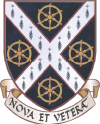Tom Phillips (1937-2022)
Tom was born in Clapham, south-west London, to Margaret (nee Arnold) and David Phillips. Margaret ran a boarding house and David speculated on cotton futures, two very different careers to the path that Tom would take.
During his time at Bonneville primary school Tom first ‘learned the word artist, and discovered that it was someone who did not have to put his paints away.’ Inspired by this revelation, Tom soon moved on to other forms of art-making, embracing music and composition alongside the visual arts throughout his life.
After attending his local grammar school, Tom went on to study English and Anglo-Saxon at St Catherine’s College in 1957. He most likely did not expect that one day his tapestries would grace the Hall at Catz, a daily reminder of his striking sense of colour and design.
During his time as an undergraduate, Tom was given the daunting task of showing Arne Jacobsen around Oxford. Pointing out the many architectural gems, Jacobsen dismissed them all as ‘mere decoration’, making it clear that his vision for the new St Catherine’s was free of such decorative frivolities. He was particularly adamant about the integrity of the college walls: they should not be ‘disturbed’.
Many years later it became evident, however, that some walls required a certain degree of disturbance, most notably the walls in the Hall, resulting in the first grand commission of Tom’s career. The interior of the Hall was felt by many to be too stark, and the tapestries were intended to lend a softening touch. Tom’s aim was to reinforce the impression of the Hall as an ancient gathering place while subduing, by a variation in texture, its overwhelming concrete presence. The resulting tapestries allude to heraldic banners, fitting for a university where identifying emblazonments play an important role.
While at St Catz, Tom attended life drawing classes at the Ruskin School. This led to his studying art full time at Camberwell School of Art, graduating in 1964. By this time, Tom was a husband and father: he had married Jill Purdy, with whom he had a daughter, Ruth, and son, Leo.
Tom drew inspiration from many sources throughout his life, resulting in a polymathic output of astounding breadth and range.
A Humument: A Treated Victorian Novel, a multimedia re-working in pen, ink, collage and paint of William Hurrell Mallock’s A Human Document, is considered by many to be his best-known work. It may have taken him over forty years to complete, but his creative approach sparked the imaginations of schoolchildren and art students alike, and could perhaps be traced back to Tom’s belief that an artist need never put his paints away.
Other notable collaborations include projects with sculptor Antony Gormley, and commissions from the Royal Mint for a £5 coin marking the 50th anniversary of the coronation, and for a gold medal, co-designed with Sir Anthony Caro, to commemorate the London Olympics. In between all this Tom managed to paint numerous portraits of his friends, including Eno, Iris Murdoch, Samuel Beckett and Pete Townshend, leading to a solo exhibition at the National Portrait Gallery in 1989. Two portraits of particular note to St Catz are the portraits he painted of past Masters, Alan Bullock and Patrick Nairne.
He was elected a Royal Academician in 1989, an Honorary Fellow of St Catz in 1992, and appointed CBE in 2002. In 2005-2006 he was made Slade professor of fine art at Oxford. His first marriage ended in 1988, and in 1995 he married Fiona Maddocks, now the music critic for the Observer.
Tom’s presence was woven into the lives of many, friends, colleagues and family. He is survived by Fiona, his children, Ruth and Leo, and by Fiona’s two daughters. At St Catz we will remember him by flying the college flag at half-mast to mark his death, and every time we enter the College and marvel at the enduring legacy of his talent.

